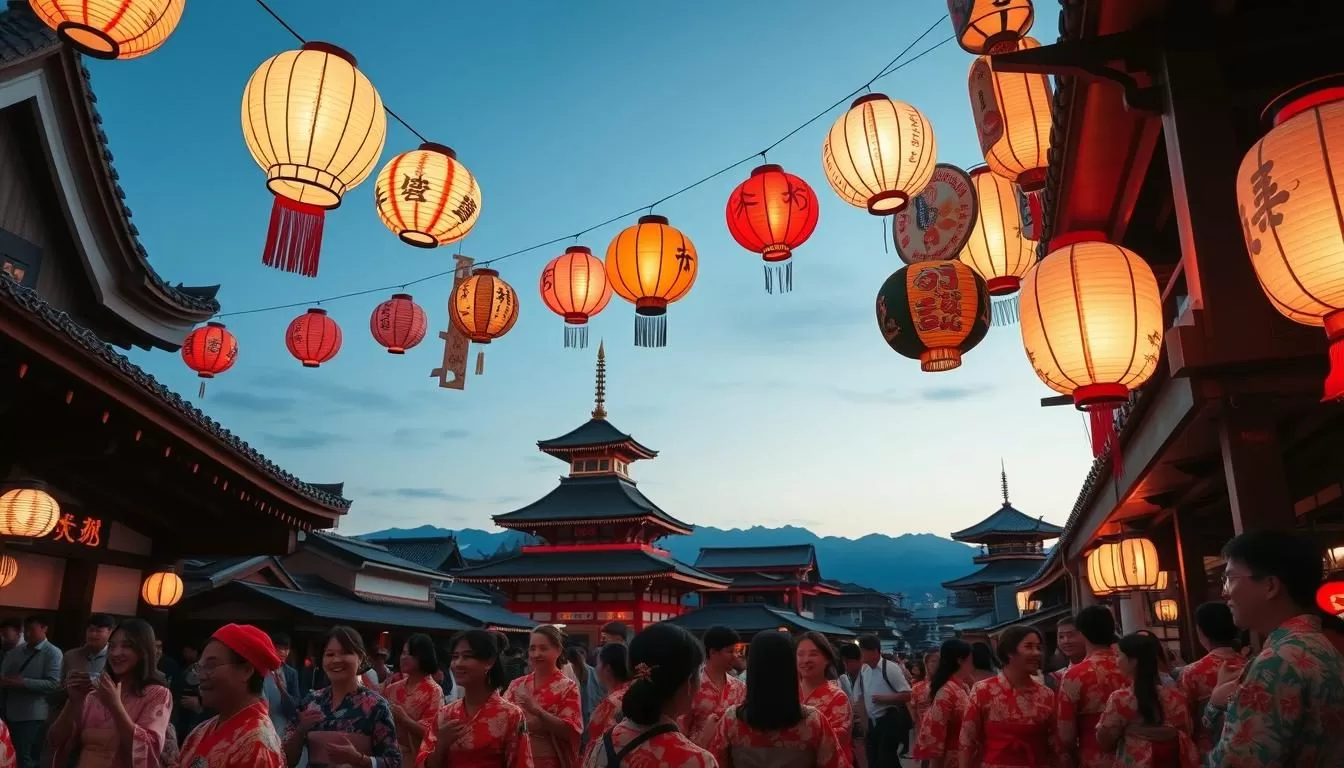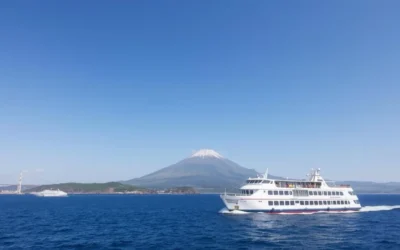Are you ready to immerse yourself in the festivals that make Japan so unique? Matsuri, or festivals in Japan, are a spectacle of color, energy, and tradition. By attending a matsuri, you’ll be treated to an unforgettable experience that showcases the country’s rich cultural heritage.
These events are a vital part of Japanese culture, with many having been celebrated for centuries. As you plan your trip to Japan, consider coinciding your visit with one of these celebrations to get a deeper understanding of the local community and its history. By doing so, you’ll not only witness the country’s vibrant culture but also become a part of it.
Understanding Japanese Matsuri Culture
Matsuri, or Japanese festivals, are an integral part of the country’s cultural identity. These events are deeply rooted in Japan’s history and traditions, offering a unique experience for both locals and visitors.
The Significance of Festivals in Japanese Society
Japanese festivals, or Matsuri, play a significant role in the country’s society. They are often tied to shrines and are believed to bring communities together. The procession of participants carrying portable shrines, known as mikoshi, is a common sight during these festivals. These events not only showcase Japan’s rich cultural heritage but also provide a platform for social bonding.
What to Expect at a Japanese Festival
When attending a Japanese festival, you can expect a vibrant atmosphere filled with traditional music and colorful decorations. The streets are often lined with food stalls, or yatai, offering a variety of seasonal specialties and traditional festival foods. The overall experience is immersive, with a mix of sights, sounds, and smells that create a unique sensory experience. Many festivals encourage audience participation, whether it’s joining in dances or helping to carry mikoshi.
- Discover the common elements found at most Japanese festivals, including colorful decorations and traditional music performances.
- Enjoy the variety of food available at temporary food stalls lining the streets.
- Experience the range of atmospheres, from solemn to wildly exuberant, depending on the celebration.
- Learn about the distinctive sights, sounds, and smells that create the immersive sensory experience.
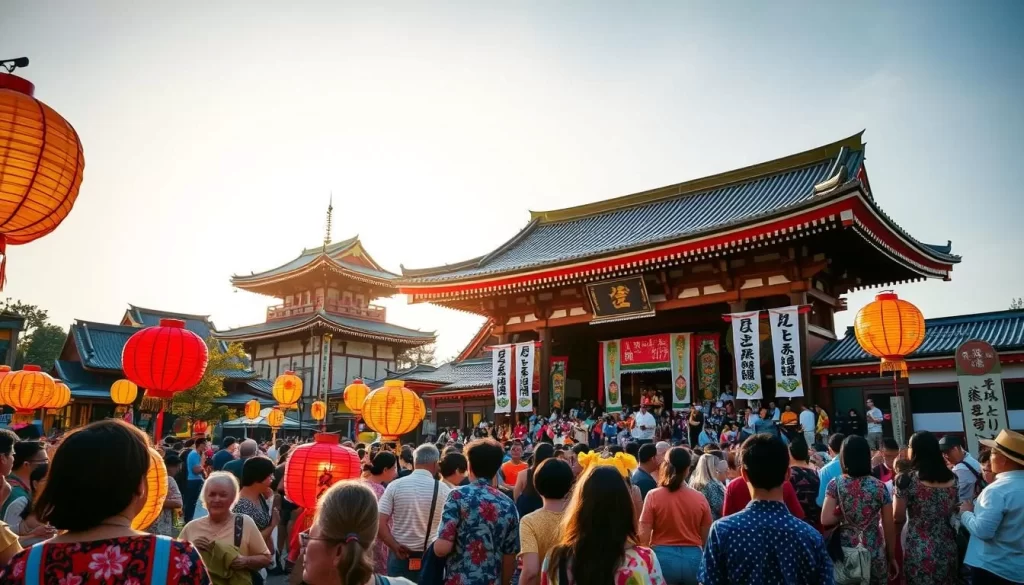
Winter Wonderland: Japan’s Top Cold-Weather Festivals
Experience the magic of Japan’s winter festivals, a perfect blend of tradition and modern celebration. As the cold weather sets in, Japan comes alive with vibrant festivals that are a treat for the senses.
Sapporo Snow Festival
The Sapporo Snow Festival, held annually in Sapporo, Hokkaido, is one of Japan’s most famous winter events. It attracts millions of visitors from around the world with its stunning snow and ice sculptures.
The festival features elaborate snow statues, some reaching as high as 15 meters, and intricate ice sculptures that glimmer under the lights. You can enjoy the festival’s atmosphere by strolling through the grounds, sampling local cuisine, and participating in various winter activities.
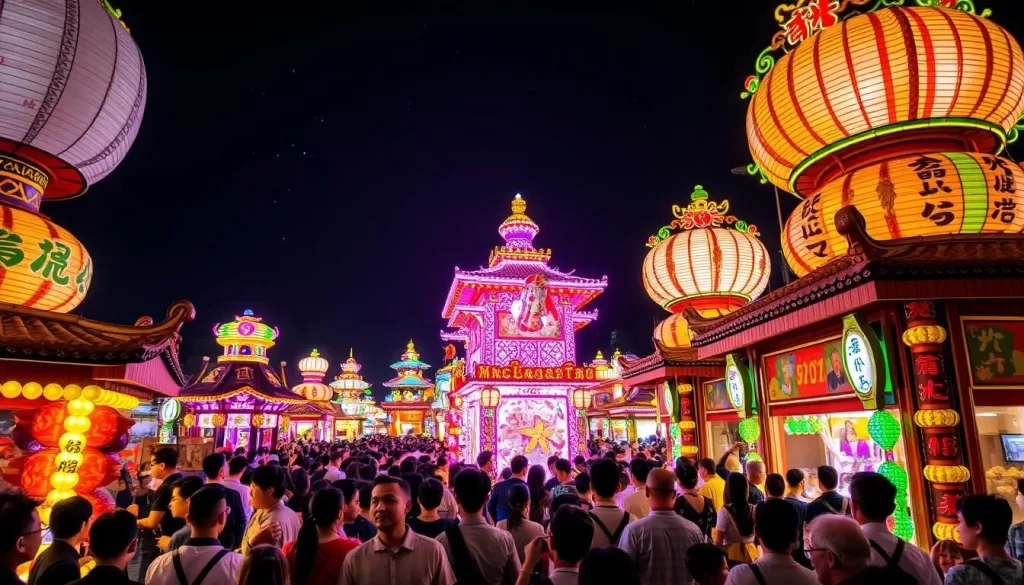
Chichibu Yomatsuri
The Chichibu Yomatsuri, or Chichibu Night Festival, is a UNESCO Intangible Cultural Heritage event that takes place in Saitama’s Chichibu Shrine. With a history spanning over 300 years, this festival is a significant cultural experience.
- You’ll experience one of Japan’s most spectacular winter festivals at the Chichibu Yomatsuri.
- The festival features elaborately decorated floats weighing up to 20 tons that are pulled through the streets of Chichibu.
- The evening procession is a highlight, with four large floats accompanied by smaller ones known as kasaboko and lively music.
- The rare winter fireworks display concludes the festival, illuminating the night sky.
- Located just 90 minutes from Tokyo, the Chichibu Yomatsuri offers an authentic festival experience.
The Chichibu Yomatsuri is a unique winter event that showcases Japan’s rich cultural heritage. The ornate floats serve as mobile stages for kabuki performances during the day and are illuminated with hundreds of lanterns for the evening procession, making it a truly unforgettable experience.
Spring Celebrations: Cherry Blossoms and Beyond
Spring in Japan is a season of breathtaking beauty, marked by festivals that celebrate the renewal of life. As the cold winter months fade away, the country transforms into a vibrant tapestry of colors and festivities that attract visitors from around the world.
Hanami: Cherry Blossom Viewing Season
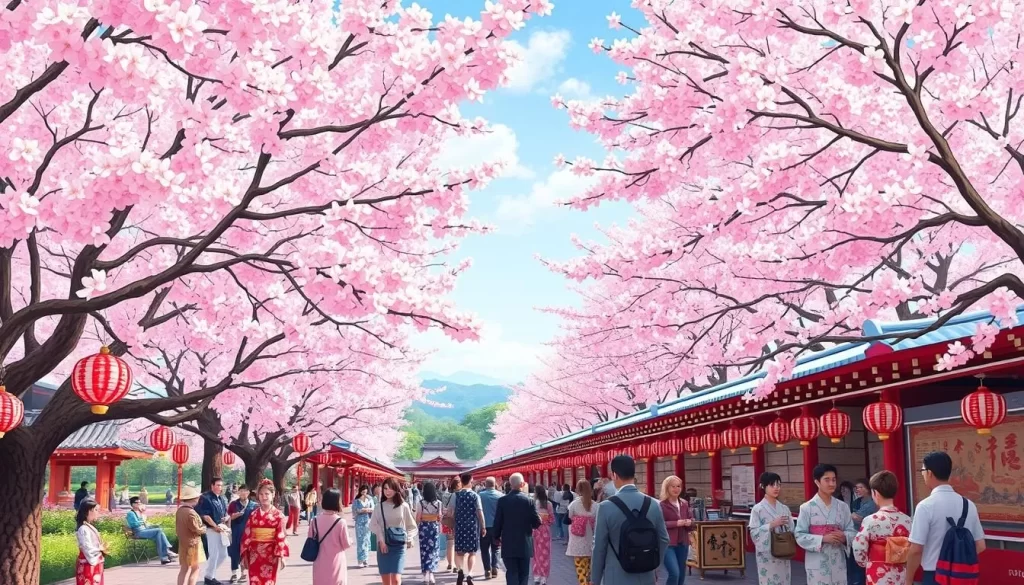
Hanami, or cherry blossom viewing, is a cherished tradition in Japan, symbolizing the fleeting nature of life. During this celebration, people gather in parks and gardens to admire the beauty of cherry blossoms. The festival atmosphere is enhanced by food stalls and traditional performances.
Aoi Matsuri in Kyoto
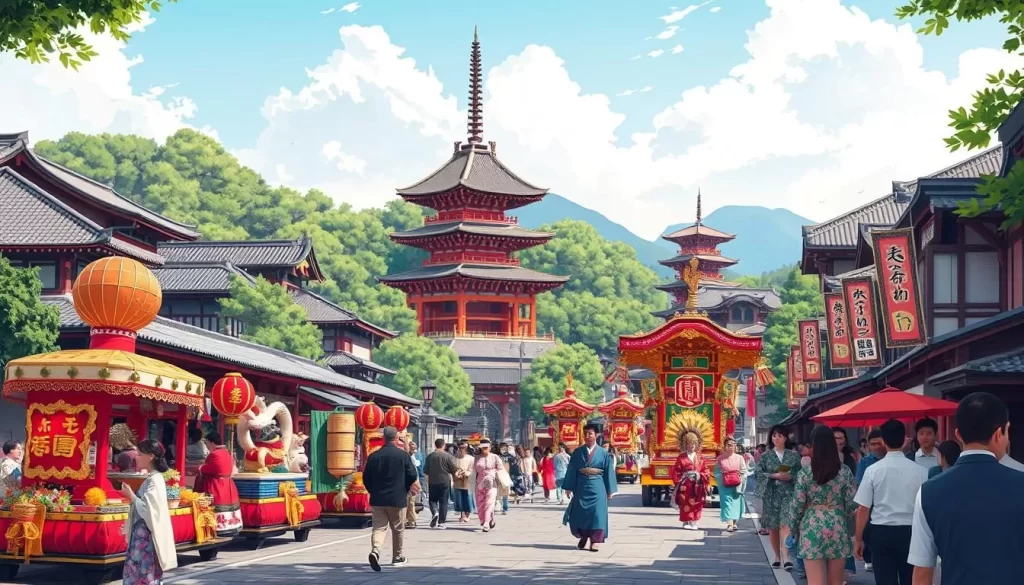
The Aoi Matsuri, held in Kyoto, is one of Japan’s most prestigious festivals. This ancient procession, dating back to the 8th century, is a stunning display of traditional Japanese culture, with participants dressed in Heian period attire. The event is a unique experience that offers a glimpse into Japan’s rich heritage.
Wisteria Festival
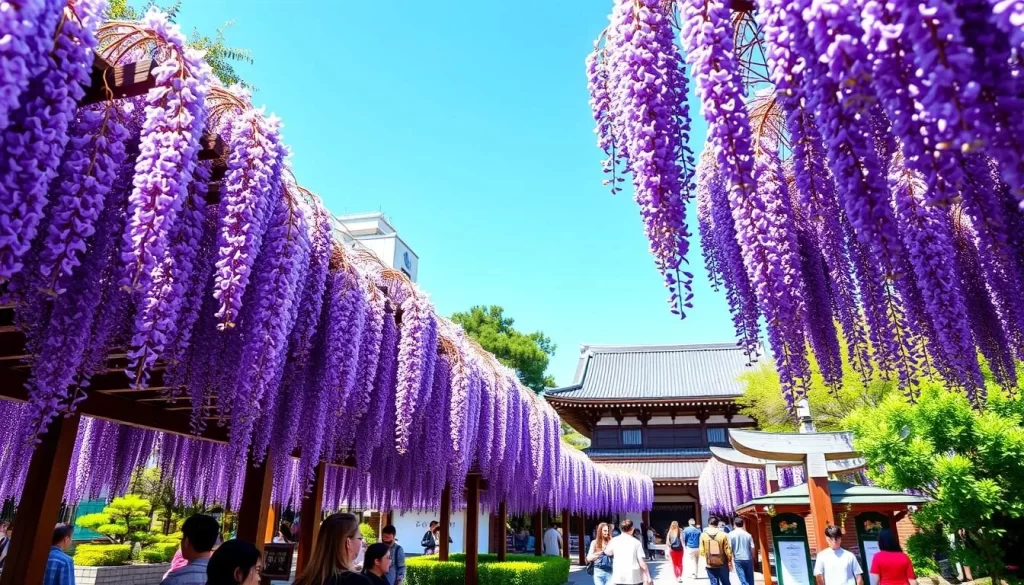
Beyond cherry blossoms, Japan’s spring season is also celebrated with the Wisteria Festival. At popular spots like the Kameido Tenjin Shrine in Tokyo and Ashikaga Flower Park in Tochigi Prefecture, visitors can marvel at the cascading purple blooms. The festival offers a less crowded but equally beautiful celebration, accompanied by seasonal food and drinks.
The Wisteria Festival is a treat for those looking for a more serene experience. The illuminated wisteria at night creates an enchanting atmosphere, making it a must-visit during spring in Japan.
Summer Heat: Japan’s Most Vibrant Festival Season
Japan’s summer is synonymous with festivals, and the energy is palpable. The season brings with it a plethora of celebrations across the country, each with its unique charm and attractions. You’ll experience the vibrant culture of Japan through its summer festivals, which are a must-visit during your travel.
Gion Matsuri in Kyoto
The Gion Matsuri, held in Kyoto, is one of Japan’s most renowned festivals. It takes place throughout July, culminating in a grand procession of elaborate floats. You’ll be mesmerized by the traditional costumes, the music, and the overall spectacle.
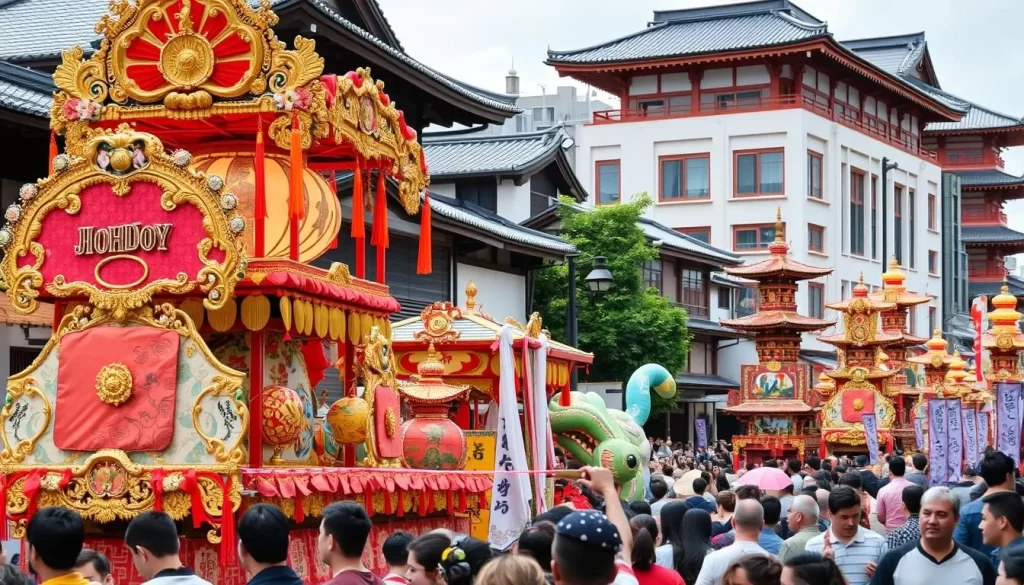
Tenjin Matsuri in Osaka
Osaka’s Tenjin Matsuri is another highlight of Japan’s summer festival season. This festival, held in July, features parades along the city’s major streets, accompanied by traditional music and dancers. The festival’s climax includes a spectacular fireworks display over the Okawa River.
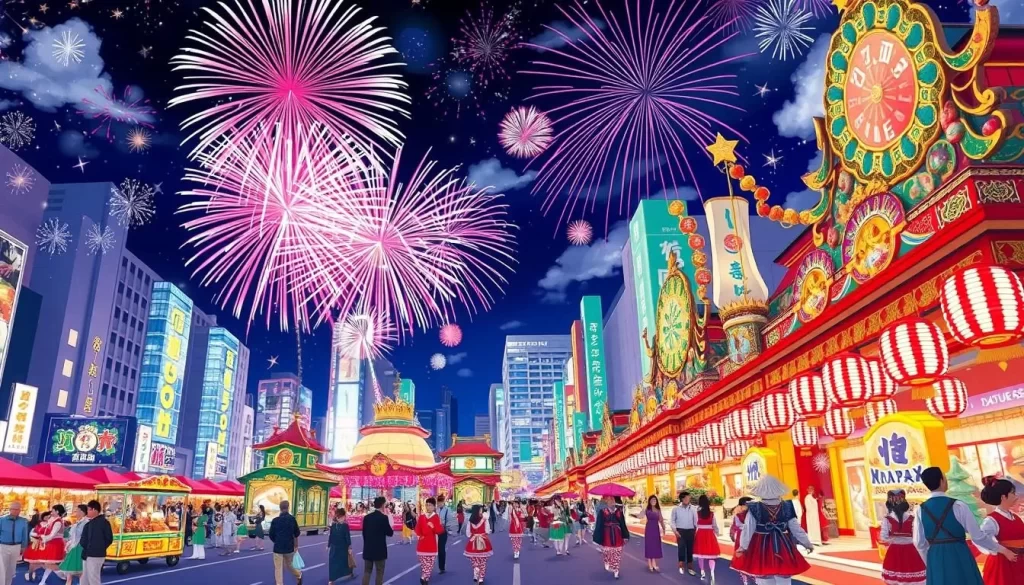
Nebuta Matsuri in Aomori
The Nebuta Matsuri, held in Aomori City, is a visual spectacle that you won’t want to miss. The festival features enormous illuminated floats that depict historical and mythological figures. As you watch, you’ll be surrounded by the energetic atmosphere created by dancers and music performers.
The Nebuta Matsuri transforms Aomori City with nightly parades from August 2-7, featuring dozens of massive paper floats that can take a full year to construct. You’ll have the opportunity to join in the festivities as a haneto dancer, wearing traditional costumes available for rent locally.
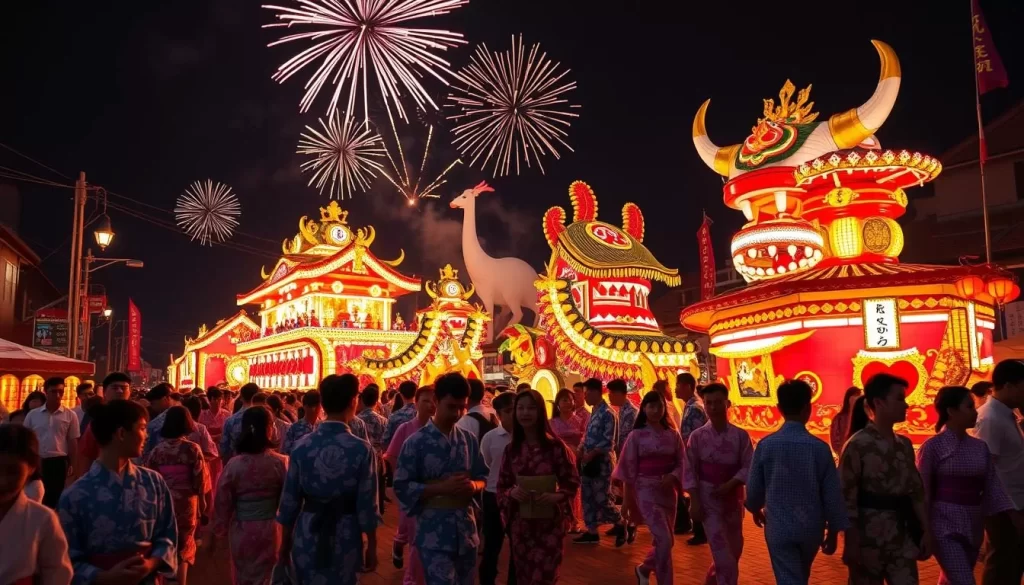
In conclusion, Japan’s summer festival season is a time of great joy and celebration. With numerous festivals happening across the country, you’re sure to find one that suits your travel plans. Whether it’s the Gion Matsuri in Kyoto, Tenjin Matsuri in Osaka, or Nebuta Matsuri in Aomori, each festival offers a unique experience that showcases Japan’s rich cultural heritage.
Japan: Top Festivals to Check Out When Visiting Tokyo
Tokyo’s festival scene is a kaleidoscope of colors, sounds, and traditions that are sure to leave a lasting impression. As you explore the city, you’ll have the opportunity to experience some of Japan’s most vibrant and unique festivals.
Kanda Matsuri
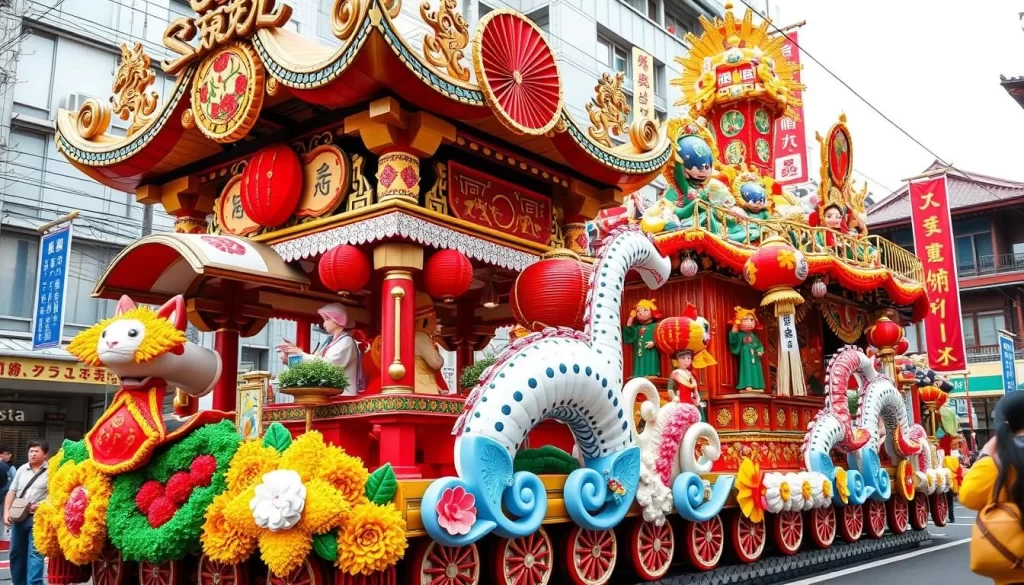
The Kanda Matsuri, held every other year, is one of Tokyo’s three major festivals. It’s a significant event that showcases the city’s rich cultural heritage, featuring elaborate floats, traditional costumes, and lively performances.
Sanja Matsuri in Asakusa
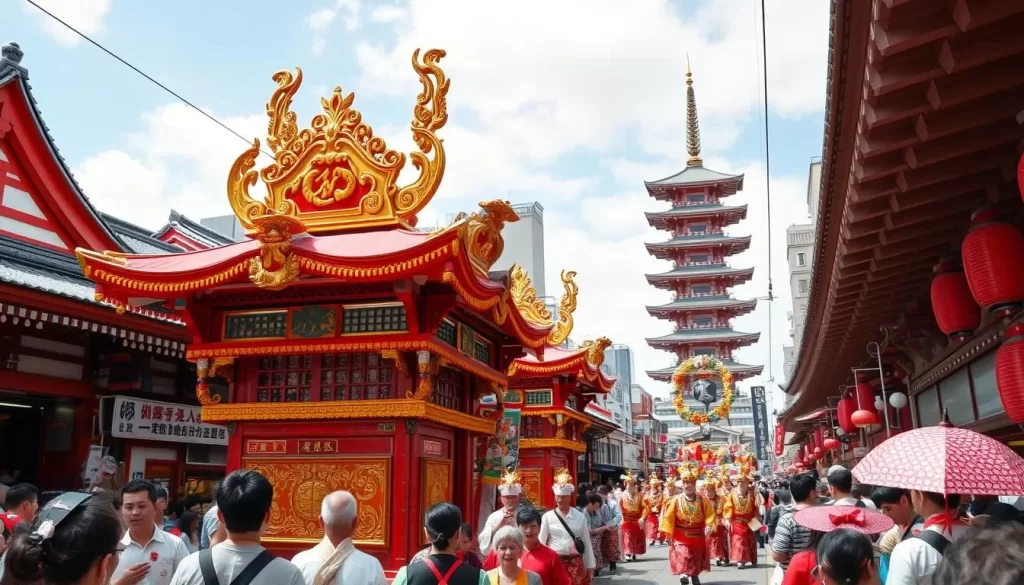
The Sanja Matsuri is a lively festival held in Asakusa, one of Tokyo’s oldest districts. This event honors the deities of the Senso-ji Temple and features traditional dances, music, and floats.
Sumidagawa Fireworks Festival
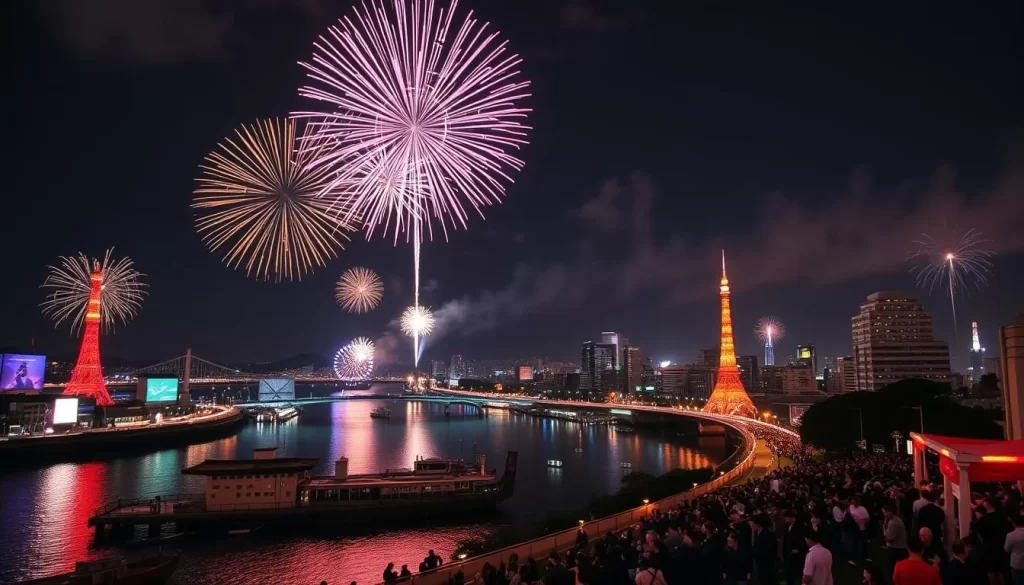
The Sumidagawa Fireworks Festival is one of Tokyo’s most spectacular summer events, attracting over a million spectators. The display features over 20,000 fireworks, creating a breathtaking spectacle against the backdrop of Tokyo’s city skyline.
This festival continues a tradition that began during the Edo period, commemorating those who died in natural disasters and plagues. You’ll join over a million spectators along the banks of the Sumida River as two separate fireworks competitions create a spectacular display that lasts for nearly two hours.
Kyoto’s Traditional Festival Calendar
As you explore Kyoto, you’ll discover a vibrant festival calendar that reflects the city’s deep-rooted cultural practices. Kyoto’s festivals are an integral part of its cultural identity, providing a glimpse into the city’s ancient traditions and customs. The city’s festivals are a testament to its rich cultural heritage, making your visit a memorable experience.
Jidai Matsuri: Festival of Ages
The Jidai Matsuri, or Festival of Ages, is a spectacular event that takes place on October 22nd every year. This festival is a grand procession of people dressed in costumes from various eras of Japanese history, showcasing the city’s rich cultural heritage. You’ll witness a unique blend of traditional clothing, music, and dance as participants recreate scenes from Kyoto’s past.
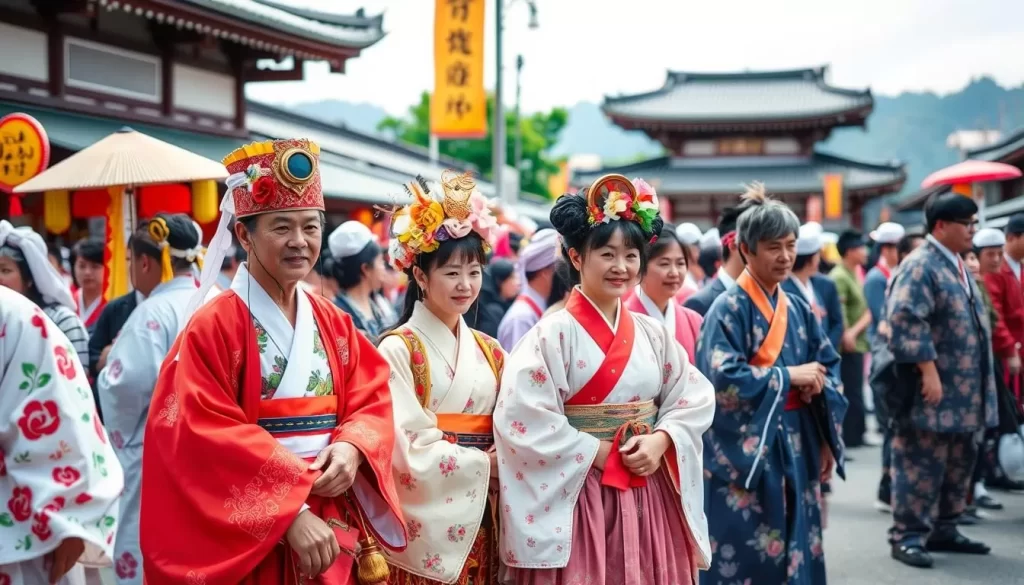
Kurama Fire Festival
You’ll experience one of Japan’s most dramatic and ancient fire festivals at the Kurama Fire Festival, held annually on October 22nd in the mountain village of Kurama, just north of Kyoto. The festival dates back over 1,000 years and features hundreds of torches that illuminate the mountain village throughout the evening. The entire village participates in this community celebration, with many residents placing pine torches outside their homes, creating a magical atmosphere as fire illuminates the mountain setting.
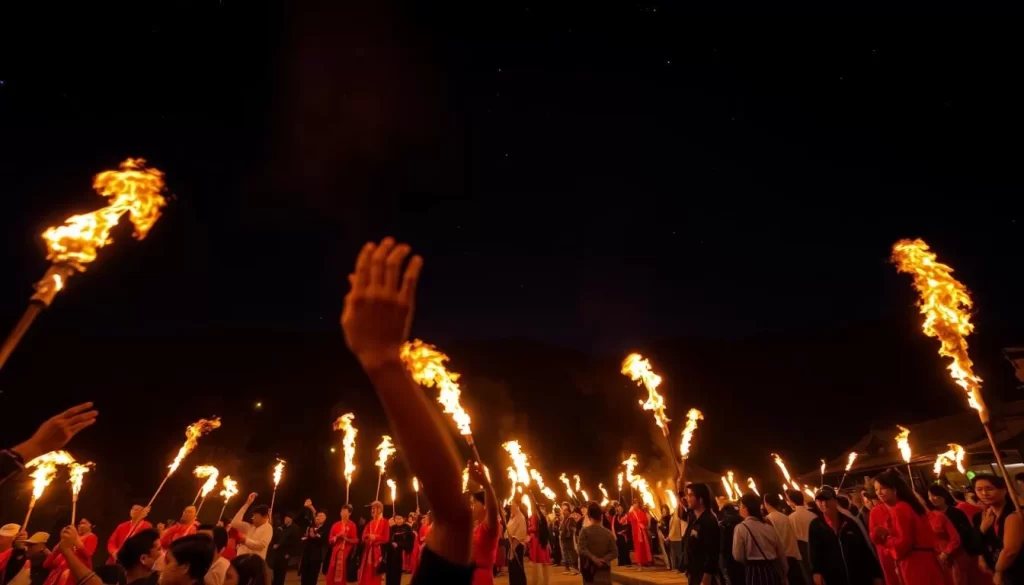
Both Jidai Matsuri and Kurama Fire Festival offer a unique glimpse into Kyoto’s traditional festival calendar, making them must-experience events during your visit to this culturally rich place. The shrine at Kurama, known as Yuki Shrine, is central to the Fire Festival, adding to the spiritual ambiance of the celebration.
Off the Beaten Path: Regional Festival Gems
Venture off the beaten path to experience Japan’s most captivating regional festivals. These events offer a unique glimpse into the country’s rich cultural heritage and are definitely worth visiting.
Awa Odori in Tokushima
The Awa Odori festival, held in Tokushima, is one of Japan’s most famous dance festivals. It takes place on August 12-15 and attracts millions of visitors. The festival features traditional dance performances, known as “odori,” which are characterized by their energetic and lively movements.
During the festival, participants wear traditional costumes and perform in the streets, creating a vibrant and festive atmosphere. The event is a great opportunity to experience Tokushima’s rich cultural heritage and enjoy the local food and drinks.
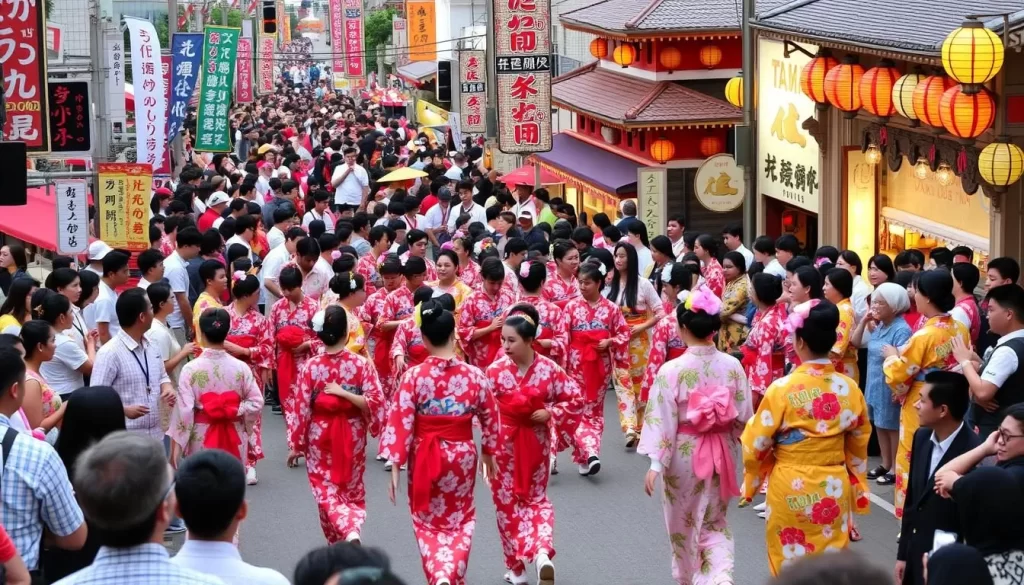
Takayama Matsuri
Takayama’s Spring and Autumn Festivals are renowned for their stunning floats, known as “yatai,” which are elaborately decorated with intricate wood carvings, metalwork, and lacquer art. The festival takes place in the historic town of Takayama, creating an immersive historical experience.
The Spring Festival, held on April 14-15, celebrates the planting season, while the Autumn Festival on October 9-10 gives thanks for the harvest. Both festivals feature evening processions when the floats are illuminated, creating a magical atmosphere.
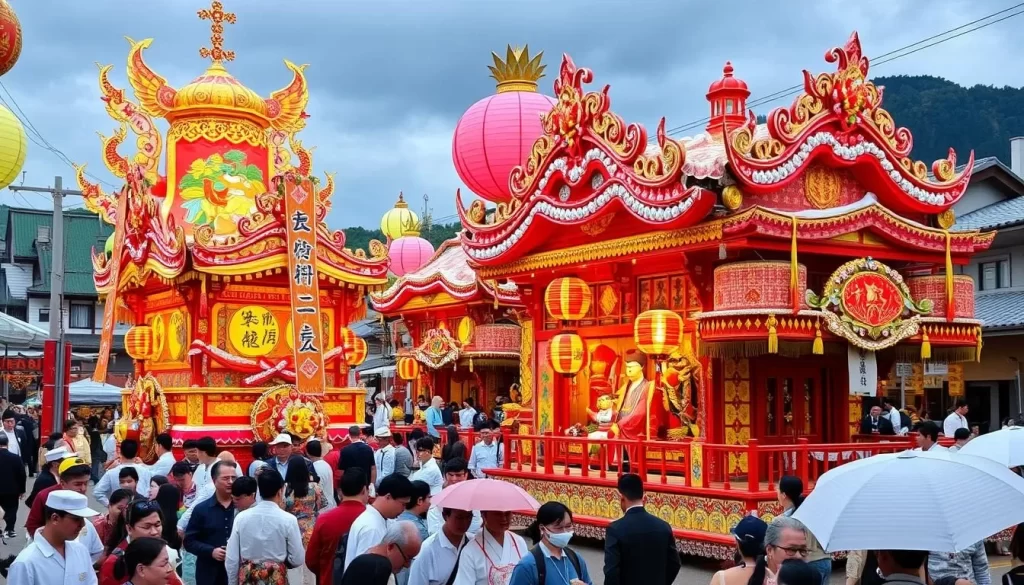
These regional festivals offer a unique and unforgettable experience, showcasing Japan’s rich cultural diversity and traditional craftsmanship. By visiting these events, you’ll gain a deeper understanding of the country’s cultural heritage and create lasting memories.
Autumn Festivities: Celebrating the Harvest Season
The arrival of autumn in Japan heralds a season of festivities, centered around the harvest and community bonding. As the summer heat dissipates, the country comes alive with various festivals that showcase its rich cultural heritage.
Autumn festivals in Japan are a time for family and community to come together, celebrating the season’s bounty. These events are deeply rooted in tradition and offer a unique glimpse into Japan’s cultural fabric.
Karatsu Kunchi Festival
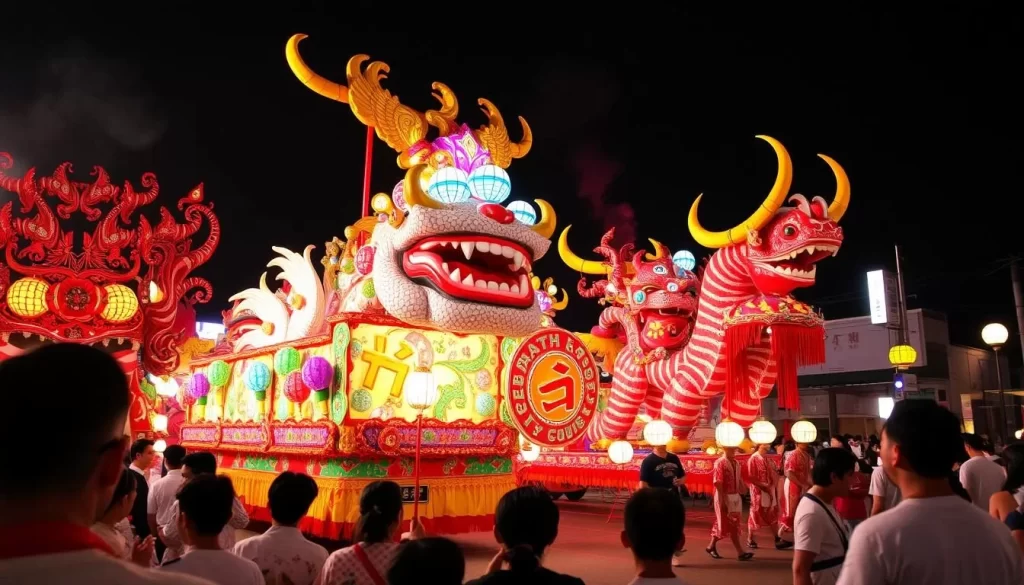
The Karatsu Kunchi Festival, held in Saga Prefecture, is one of Japan’s most renowned autumn festivals. It features elaborate floats, traditional dances, and martial arts performances, attracting visitors from across the globe.
This festival is a significant celebration in the region, highlighting the importance of community and cultural heritage.
Shichi-Go-San: 7-5-3 Day

Shichi-Go-San, or 7-5-3 Day, is a traditional celebration where Japanese families with children aged three, five, and seven visit Shinto shrines to pray for their health and growth. This celebration is a significant time for family bonding and is steeped in history, dating back to the Heian period.
During this celebration, children are dressed in their finest traditional clothing, and the atmosphere is filled with joy and festivity. The tradition includes the giving of chitose-ame, or thousand-year candy, symbolizing the wish for children to grow strong and healthy.
Spectacular Hanabi: Japan’s Fireworks Festivals
Japan’s summer is synonymous with vibrant fireworks festivals, known as hanabi, which light up the night sky across the country. These festivals are a significant part of Japanese culture, offering a unique experience for both locals and tourists.
Summer Fireworks Traditions
The tradition of hanabi in Japan dates back centuries, with summer being the peak season for these fireworks displays. The festival atmosphere is electric, with large crowds gathering to witness the spectacular display of fireworks over rivers, lakes, and oceans.
Top Fireworks Displays Across Japan
Some of the most notable hanabi festivals include the Sumidagawa Fireworks Festival in Tokyo, known for its historical significance and large-scale fireworks display. The Nagaoka Fireworks Festival in Niigata Prefecture is famous for its “Phoenix” display, symbolizing the city‘s recovery. Other notable mentions include the Omagari Fireworks Competition in Akita Prefecture and the Miyajima Water Fireworks Festival near Hiroshima.
To make the most of your visit to these events, it’s advisable to arrive early to secure a good viewing spot, as these festivals can attract over a million spectators. Some festival organizers also offer special viewing areas for a more exclusive experience.
Unique and Unusual Japanese Festivals
Beyond the typical Japanese festivals, there are some that are truly one-of-a-kind. These events showcase the country’s diverse cultural heritage and offer visitors a chance to experience something truly unique.
Kanamara Matsuri
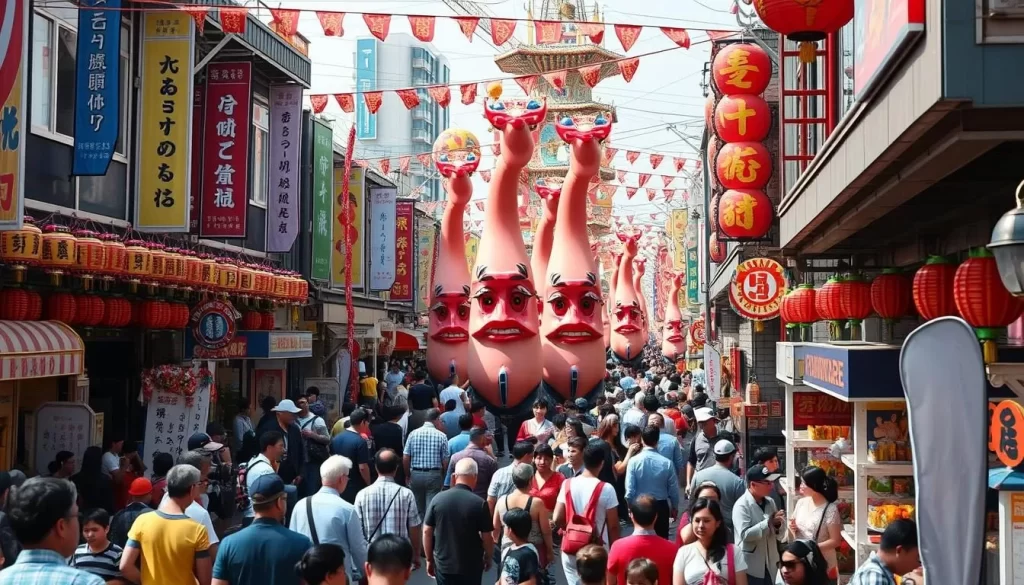
The Kanamara Matsuri, held in Kawasaki, is a festival that celebrates fertility and good luck. It’s known for its colorful and sometimes provocative decorations and procession.
Omizutori at Todaiji Temple
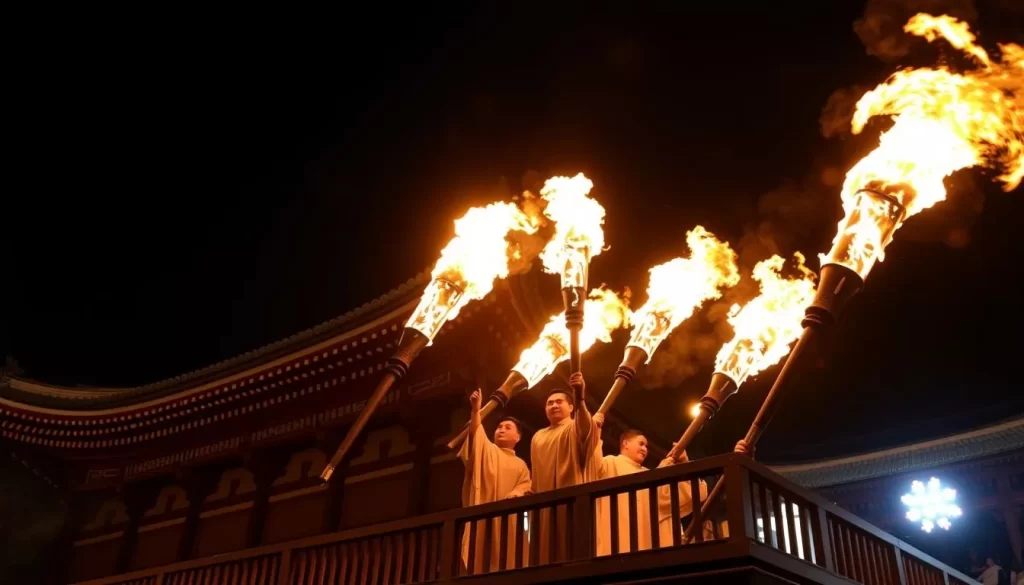
Omizutori, a sacred fire ceremony at Todaiji Temple in Nara, is one of Japan’s oldest Buddhist rituals, performed annually for over 1,250 years. The ceremony involves priests carrying massive burning torches, and the falling embers are believed to bring good fortune and protection.
Practical Tips for Enjoying Japanese Festivals
To make the most of Japan’s vibrant festivals, it’s essential to be well-prepared. When planning your trip to coincide with major events like the Gion Matsuri or Sapporo Snow Festival, book your accommodations at least 6-12 months in advance to avoid high prices and availability issues.
Arriving early at popular festival parades and fireworks displays is crucial to secure a good viewing spot. You can enhance your experience by trying seasonal foods from food stalls, known as yatai, which offer unique delicacies available only during the festival period.
- Wear comfortable shoes, as most festivals involve significant walking or standing.
- Be mindful of photography restrictions at religious festivals and respect participants, especially during ceremonies.
- Stay comfortable in crowds and summer heat by bringing essentials like a folding fan, towel, and water bottle.
By being prepared, you can fully enjoy the vibrant atmosphere and unique traditions of Japan’s festivals during your trip.
The above is subject to change.
Check back often to TRAVEL.COM for the latest travel tips and deals.
